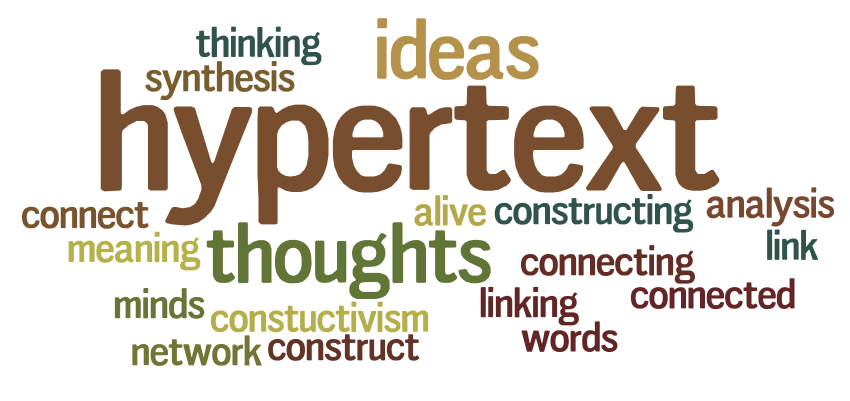History
Vannevar Bush documented the first instance of hypertext in a 1945 Atlantic Monthly article about a device called a Memex that could make and follow links. “A memex is a device on which an individual stores all his books, records, and communications, and which is mechanized so that it may be consulted with exceeding speed and flexibility” (Bush). They go on to say it is a supplement to his or her memory, one that is stored on a microfilm for easy reference. In 1965, Ted Nelson coined the word hypertext, and in 1980, Tim Berners-Lee wrote a program entitled “Enquire-Within-Upon-Everything” that allowed linking between nodes. He was a pioneer of the issue, also writing something called “Information Management: A proposal,” which “discusses the problems of loss of information about complex evolving systems and derives a solution based on a distributed hypertext system” (Berners-Lee). This proposal was for CERN, or the European Council for Nuclear Research, which along with Tim Berners-Lee, helped invent the World Wide Web in 1989. According to the CERN website, the WWW was originally made to meet the demand for a high-speed, or automatic, information sharing between the scientists and universities across the world. Theorists of this time period often had their writings “filled with praise for this electronic medium as well as the rhetoric of salvation for their field” (Baehr and Lang 41). Some of the traits attributed to hypertext included links that enable pathways through the texts, nodes/chunks, nonlinearity, and space for collaborative authoring and editing.  In the eyes of many, hypertext was a way to generate more interest in the field of literary studies. “Both Landow and Richard Lanham forecast a changing of the guard from print to electronic in literary studies, yet both authors sought to reassure readers that whatever revolutionary possibilities that hypertext contained would be harnessed for the greater good of literary studies (Baehr and Lang 42). If we look at how much the field has progressed since the early 90’s, hypertext has certainly had a positive impact on literary studies. Technically, hypertext as we know it was Hypertext 1.0, which was obviously followed my Hyptertext 2.0. It is important to note that these terms are more of a buzzphrase, not necessarily indicative of better features. Sure, the features improved over time, but it was more of a selling point rather than an actual new platform. Both platforms shared many features that allowed users to find the optimal way of working with the given information.
In the eyes of many, hypertext was a way to generate more interest in the field of literary studies. “Both Landow and Richard Lanham forecast a changing of the guard from print to electronic in literary studies, yet both authors sought to reassure readers that whatever revolutionary possibilities that hypertext contained would be harnessed for the greater good of literary studies (Baehr and Lang 42). If we look at how much the field has progressed since the early 90’s, hypertext has certainly had a positive impact on literary studies. Technically, hypertext as we know it was Hypertext 1.0, which was obviously followed my Hyptertext 2.0. It is important to note that these terms are more of a buzzphrase, not necessarily indicative of better features. Sure, the features improved over time, but it was more of a selling point rather than an actual new platform. Both platforms shared many features that allowed users to find the optimal way of working with the given information.
In relation to education, hypertext has made a huge difference in the lives of both students and teachers. The way we move through pages and websites to find only the pertinent information is because of hypertext. Students in particular do a lot of researching on websites these days, and they do not have the time to click around endlessly. Through the concept of hypertext, we are able to link students to the information they may need on the home page. This can bring them to the relevant information within seconds, saving time and effort. As we look at the history of hypertext, “the ways in which information management and data analysis applications have evolved along lines reminiscent of traits described by hypertext theorists” (Baehr and Lang 52). As time went on, these traits we discussed in the very beginning of the life of hypertext have evolved into crucial pieces of communication in our daily lives. According to Craig Baehr and Susan Lang, this has allowed us to move from collaborative authoring to a collaborative and meta-discursive authorship, or essentially a way for authors to discuss the authorship. This will benefit both students and teachers as we move toward a newer model of collaboration. As technical communicators, we want to get the users information as quickly as possible. Hypertext allows for this because users can click around on the website and find the information they came for. When users click through the links on the pages, it is more likely the reader will stay on our website rather than going to a different one.
Links are an integral part of hypertext, for they are what carries users to the information they need. Hypertext has the advantage of being nonlinear and non-sequential, which makes it a major advantage for users trying to find specific information. “Because a hypertext is not linear, it shows interrelationships between subjects and mimics more naturally the organization of a human mind” (Tovey 372). Links allows users to move through the hypertext as they please, not necessarily in the way they are presented.  In this case, the user is allowed more power and control over the document, as said they would with a regular linear text. Readers bring their own experiences and understandings to the text, but hypertext allows them the freedom to get the information they need in a more streamlined fashion. Links are organizational tools that help users get to information and complete their goal, whatever that goal may be.
In this case, the user is allowed more power and control over the document, as said they would with a regular linear text. Readers bring their own experiences and understandings to the text, but hypertext allows them the freedom to get the information they need in a more streamlined fashion. Links are organizational tools that help users get to information and complete their goal, whatever that goal may be.
In addition to links, hypertexts use metaphors and buttons to aid users into recognizing the organizational patters of the hypertext so they may discover and make connections on their own. A metaphor that usually helps viewers understand hypertext better is the phrase “web of intertexuality” (Tovery 374). This metaphor refers to the way users can go many different ways from the home page, drawn whichever way by their own needs and experiences. It is said that these associations we make “reflect the intricate web of associations and information that make up human processes more accurately than does the linear model indicative of the book [metaphor]) (Tovey 374). Buttons are also an integral part of a hypertext, but require less creativity. Buttons should indicate a way to go home, a way to search, or even to go forward/back. For the reader, it is best these buttons remain the same shape and remain in the same location so users have a better chance of utilizing them. They enable users to move through a document to find pertinent information, which is sometimes a single fact in a large hypertext. Tovey says that consistency and simplicity (374) are the most important factors in relation to on-screen texts for they allow users to access different information as they please.
